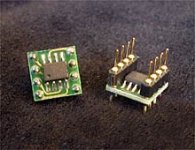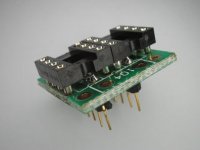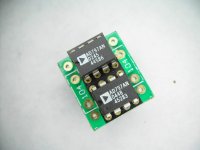I have recently pitted a few opamps against each other. Full list may follow, feel free to nag me for the details. I'm just filling this in during the commercial brake of CSI 🙂
My configuration is PCM1704 to twice first-order inverting amp with series R and R||C feedback. Very simple IVC. During testing, OPA2134 and OPA1612 came out good. OPA1642 was clearly beat by OPA1612 being more "rocky" and forward. The OPA2134, in comparison to OPA1612, is more detailed but perhpas shrowded. Newest offerings from National and Linear both lost to the TI's. Sorry, don't have the part numbers in front of me.
Temporary conclusion may be OPA1612 for Springsteen and OPA2134 for Pinnock. But I still have two AB tests going on between the two, eagerly awaiting the results. However, on relatively simple headphones on an old NAD amp the OPA1612 is clearly a fantastic amp.
Bear in mind that my configuration doesn't need much CMRR, and that the feedback structure is simple. Results may be different for higher order structures.
Cheers,
Borge
My configuration is PCM1704 to twice first-order inverting amp with series R and R||C feedback. Very simple IVC. During testing, OPA2134 and OPA1612 came out good. OPA1642 was clearly beat by OPA1612 being more "rocky" and forward. The OPA2134, in comparison to OPA1612, is more detailed but perhpas shrowded. Newest offerings from National and Linear both lost to the TI's. Sorry, don't have the part numbers in front of me.
Temporary conclusion may be OPA1612 for Springsteen and OPA2134 for Pinnock. But I still have two AB tests going on between the two, eagerly awaiting the results. However, on relatively simple headphones on an old NAD amp the OPA1612 is clearly a fantastic amp.
Bear in mind that my configuration doesn't need much CMRR, and that the feedback structure is simple. Results may be different for higher order structures.
Cheers,
Borge
well thats confusing, OPA1641 for me is superb and beats out 1611 without any trouble. OPA827 wins over both of them though
In my experience with I/V, the opamp's sound is strongly influenced by the feedback components around it. Different opamps need different values to give their best. It would be really helpful when comparing opamps to show schematics showing the configuration in use.
well thats confusing, OPA1641 for me is superb and beats out 1611 without any trouble. OPA827 wins over both of them though
Well, at least we don't have to compare vintages! My layout only supports dual op-amps, so the OPA827 can't be tested on my current platform. It would be fun if they made a dual.
In your opinion, how does it compare to the OPA627?
Cheers,
Borge
Yes. Unfortunately no longer internal schematics are released from new developements like the LME-Series, the OPA-627 successors and some other. So I cannot exactly determine, what is the best design arround the feedback resistor values.In my experience with I/V, the opamp's sound is strongly influenced by the feedback components around it. Different opamps need different values to give their best.
Anywhere here on diyaudio exist a thread, how I can make a small PCB for two single OP-AMP appropriate for testing in a socket for a dual OP-Amp. Unfortunately I don't know the headline and the aera, where this thread is filed.Well, at least we don't have to compare vintages! My layout only supports dual op-amps, so the OPA827 can't be tested on my current platform. It would be fun if they made a dual.
In your opinion, how does it compare to the OPA627?
Cheers, Borge
Last edited:
Anywhere here on diyaudio exist a thread, how I can make a small PCB for two single OP-AMP appropriate for testing in a socket for a dual OP-Amp. Unfortunately I don't know the headline and the aera, where this thread is filed.
That could come in handy. But I've started using SMD packages so that I can get the decoupling closer to op-amp pins. In my layout I use a continuous ground plane directly under the chip with the ground pad of the decouplers on this plane and the power pins very close. I'm a bit worried about stray inductance in op-amp risers.
Cheers,
Borge
... "op-amp risers" - this term I have never heard before - excuse my not perfect english. Mean you the leads/printed wires to the inverted and non inverted input?That could come in handy. But I've started using SMD packages so that I can get the decoupling closer to op-amp pins. In my layout I use a continuous ground plane directly under the chip with the ground pad of the decouplers on this plane and the power pins very close. I'm a bit worried about stray inductance in op-amp risers.
Cheers,
Borge
ckeck ebay Item number 220677386848 (dual inline) and 370351701454 (smt/smd so-8) so as follow URL:
Browndog Single to Dual Opamp Adaptor Page
Attachments
In my experience with I/V, the opamp's sound is strongly influenced by the feedback components around it. Different opamps need different values to give their best. It would be really helpful when comparing opamps to show schematics showing the configuration in use.
agreed, but I just couldnt help myself in this instance. mainly because although the 1611/12 series are technically very sound, I find them boring as hell. not just because they are so clean, there is that, but so are the others I mention, but I dunno, I just find there is a difference between clean and sterile.
WRT OPA827 vs OPA627, for some reason I just have never found I like the 627, in higher gain circuits the 637 can work for me, but IMO the 827 is not only technically more accomplished, but its less fickle and more dynamic. 627 can sound a bit too smooth for my liking. both are claimed unity gain stable chips, but I have found that opa827 is happier like this. so its great in IV, great as buffer and also makes quite a good servo.
for the adapters, the browdogs are about the most expensive and worst implimentation of this idea, the most available for sure, but we are on DIYA here. I suggest checking out the boards by DIYA member peranders of sjostromaudio.com he has produced a single soic8- single dip8, a 2 x single soic8->dual Dip8 and dual soic8 to dual dip8. all provide ample positions for decoupling the power supplies right there on the adapter.
Last edited:
Anywhere here on diyaudio exist a thread, how I can make a small PCB for two single OP-AMP appropriate for testing in a socket for a dual OP-Amp. Unfortunately I don't know the headline and the aera, where this thread is filed.
I have now found the URLs:I suggest checking out the boards by DIYA member peranders of sjostromaudio.com he has produced a single soic8- single dip8, a 2 x single soic8->dual Dip8 and dual soic8 to dual dip8. all provide ample positions for decoupling the power supplies right there on the adapter.
http://www.diyaudio.com/forums/group-buys/166811-group-buy-so08-dil08-adapter-adp0r0.html
Group buy: ADP05 SO08 to DIL08 adapter - diyAudio
sjostromaudio.com - ADP01 ADP02 ADP03 ADP04 High End SMD to DIL adapters
yep, thats the ones, much better than the browndogs, only thing is you still have to supply the DIL pins. I have a heap of the adp01/02/03/04 and use them regularly last night even, I have been thinking about getting some of the new boards too
Krell's Approach with discrete OP-AMP
Who have heard this topology?
http://www.diyaudio.com/forums/digital-source/67377-re-draw-i-v-sch-krell-sbp-32x-dac.html
Who have heard this topology?
http://www.diyaudio.com/forums/digital-source/67377-re-draw-i-v-sch-krell-sbp-32x-dac.html
a simple resistor is better as each OP-AMP that I know - please refer for the exactly value
http://www.dddac.de/pcm63/DAC_I-V_Resistor.htm
(easy to realize for check out the sound quality)
for ultimate sound quality you need the I/U converter from Papa Nelson Pass - please refer in this case therefore the follow URLs:
http://www.diyaudio.com/forums/showthread.php?threadid=9910
http://calab.kaist.ac.kr/~cgkim/audio/amp/zen/www.passlabs.com/d1_ua.htm
http://www.diyaudio.com/forums/showthread.php?threadid=78968
http://www.head-fi.org/forums/f6/pass-labs-d1-clone-kit-324197/
http://www.head-case.org/forums/do-yourself/3914-opinions-pass-d1-clone.html
Until this day I haven't discover an OP-Amp with similar sonic quality. For me it is amazing, that most of the hobby and commercial developers don't use this solution
in the last years I have made the same observations.The best op-amp for an I-V converter is no op-amp. As Barrie Gilbert (one of the top analog designers of all time) explains, an op-amp is in reality just an integrator. This causes all kinds of problems with input stage overload when presented with the step output of a DAC. Anything (transformer, resistor, discrete, etc.) will sound better than an op-amp for an I-V converter.
But what about the newest generation of operational amplifier IC's?
In the moment I have get a diy dac for tweaking with PCM1704, DF1704 and LT1163. My favorite solution is the approach from Nelson Pass (the D1-I/U) but in this case the presently space is too small therefore.
Which from the newest OP-Amp could clearly beat Linear technology's LT1363 ??
LT1363 - 70MHz, 1000V/µs Op Amp - Linear Technology
Maybe the LMH6629 about the follow URL?
http://www.national.com/pf/LM/LMH6629.html#Overview
http://focus.ti.com/general/docs/nationalsemiconductorproducts.tsp?genericPartNumber=LMH6629
http://www.youtube.com/watch?v=BTAQ07gG2CE
http://technikweblook.com/index.php?module=Pagesetter&func=viewpub&tid=5&pid=3840
Thank you for comments.
Last edited:
as i/u converter for R2R output section?My current favorite is the LME49990.
about
High-Speed Amplifiers | National Semiconductor
and
High-Speed Current Feedback Amplifiers | National Semiconductor
is listed the type LMH6703
LMH6703 - 1.2 GHz, Low Distortion Op Amp with Shutdown
could be also of interest in an I/U application for the PCM1704
also Analog Devices listed a lot of models for this:
http://www.analog.com/en/high-speed-op-amps/high-speed-differential-amplifiers/products/index.html (High Speed Differential Amplifiers)
http://www.analog.com/en/high-speed-op-amps/current-feedback-amplifiers/products/index.html (Current Feedback Amplifiers)
http://www.analog.com/en/high-speed-op-amps/high-output-current-amplifiers/products/index.html (High Output Current Amplifiers)
Last edited:
The LT1818 looks to be a faster version of the LT1363 - same internal architecture. Might be worth a try as using 'native' CFB amps is a little inflexible over the choice of resistor value.
Recently I've been playing with passive I/V followed by AD603 (which has internal volume control) and AD605 :
http://www.analog.com/static/imported-files/data_sheets/AD603.pdf
http://www.analog.com/static/imported-files/data_sheets/AD605.pdf
Recently I've been playing with passive I/V followed by AD603 (which has internal volume control) and AD605 :
http://www.analog.com/static/imported-files/data_sheets/AD603.pdf
http://www.analog.com/static/imported-files/data_sheets/AD605.pdf
Passive conversion increases the noise and distortions. It's a dead end.
new generation OpAmps where TESTED by Sabre manufacturers and they outperform anything that passives can do.
THD at -114...116dB and SNR at -126...132dB.
http://www.esstech.com/PDF/Application_Note_Component_Selection_and_PCB_Layout.pdf
new generation OpAmps where TESTED by Sabre manufacturers and they outperform anything that passives can do.
THD at -114...116dB and SNR at -126...132dB.
http://www.esstech.com/PDF/Application_Note_Component_Selection_and_PCB_Layout.pdf
There is absolutely no comparison with any passive solution in that document so stating that it is a "dead end" is a bit beneath the truth. "Passive conversion increases the noise and distortions" ?!?!? No passives were even TESTED.
Opamps are common and the most easy to implement. Even a monkey can design (read: copy the data sheet example) with opamps which can be seen how they are implemented in some devices. That are the reasons why they are used a lot. Opamps can sound extremely well too, don't understand me wrong. Besides that it is all about cost as you can read. ESS likes its DAC chips to be sold in large numbers and they had out how to implement their products the cost effective, small and relatively cheap way with a small chance for failures. One day they maybe will even give away complete PCB layouts too like Realtek does. Together with a BOM, you will only have to change the brand name on the PCB design. The McDonalds way of manufacturing electronics if you like. Lowest cost, proven design etc.
Anyway, you should hear good output transformers once (not necessarily in these Sabre DACs as I never used these). I do like their suggestion for the Avcc a lot and will test that one. That is the one that makes the DAC perform better.
Opamps are common and the most easy to implement. Even a monkey can design (read: copy the data sheet example) with opamps which can be seen how they are implemented in some devices. That are the reasons why they are used a lot. Opamps can sound extremely well too, don't understand me wrong. Besides that it is all about cost as you can read. ESS likes its DAC chips to be sold in large numbers and they had out how to implement their products the cost effective, small and relatively cheap way with a small chance for failures. One day they maybe will even give away complete PCB layouts too like Realtek does. Together with a BOM, you will only have to change the brand name on the PCB design. The McDonalds way of manufacturing electronics if you like. Lowest cost, proven design etc.
Anyway, you should hear good output transformers once (not necessarily in these Sabre DACs as I never used these). I do like their suggestion for the Avcc a lot and will test that one. That is the one that makes the DAC perform better.
Last edited:
THD at -114...116dB
Still of the view that THD is one of the most important measures for a DAC's sound quality? Good luck with that 😀
Well, yes and no. The LME497x0 parts have a differential input impedance of 30k---that'll be an on die resistor---so in ESS's app note the DAC sees either a 15k or a 30k passive load depending on the output topology. One could substitute a second or third order passive filter of comparable impedance, at which point you either need an output buffer or some good noise management over the interconnect to the power amp. As well as in the power amp's input stages; building an input with PSRR, linearity, and noise figure comparable to a 497xx, 49990, 797, or similar is tough. If the power amp has feedback and gain then keeping the current noise in the feedback loop to reasonable levels is tough too---high output impedance from the DAC means high input impedance to the amp to get a good signal level to the input stages and voltage gain on the output means a higher feedback impedance.No passives were even TESTED.
An output trafo is similarly tricky. Drop the output filter's source impedance to a few tens of ohms for reasonable noise rejection on the interconnects and the output signal level drops to hundreds of microvolts if the full DAC swing's being used, less than that if the bit depth on the DAC's not well managed. Makes maintaining a good signal to noise ratio challenging. Reduce the turns ratio to avoid that problem and one moves back towards the difficulties maintaining good noise rejection over the interconnect. Only with added challenge in keeping the power amp inputs happy due to the lowered signal level---not much point in sweating it to get full performance out of an ES9018 if you're just going to throw it away in the power amp, after all.
If the topology's DAC to a preamp things are a bit easier; the pre probably uses unity gain op amps, mitigating most of the issues. Still, any way I look at it, I'm not seeing a good way to get a reliable design win from a passive solution once you hook up the stuff to make music come out of the DAC. For example, the room temperature Johnson noise on a 15k resistor over a 20k audio bandwidth is 2.2uV. So unless it's filtered somehow one ends up with a noise floor around -126dBFS---0 to 6dB higher than what's in ESS's app note. Let me know if I'm missing something here.
ESS's use of a cap swamped op amp as an AVcc regulator is creative. It's also problematic as the DAC pulls enough current to brown out the op amp even at moderate clock rates and, to the extent that folks here on DIYA ever agree about anything, there seems to be consensus higher clocks sound somewhat better. One can get around this by using high current parts like the LME49726 and mitigate it by using separate output channels on the op amp for the DAC's left and right supplies. But it's unclear whether managing the op amp's phase margin and keeping the filtered DVDD reference quiet is better or worse than an equally carefully designed approach using good regulators such as the ADP150 or ADP151. I have access to the test and measurement gear to measure differences but when comes to doing to $250 four layer board runs I begin to question how much I really need to know if one solution is a couple dB better than the other.
- Home
- Source & Line
- Digital Line Level
- Best opamp for I/V conversion? (DAC)


